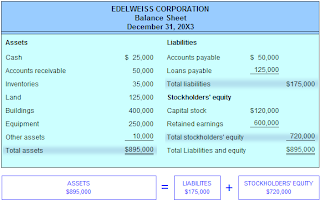

The fundamental accounting equation is the backbone of the accounting and reporting system. It is central to understanding a key financial statement known as the balance sheet (sometimes called the statement of financial position). The following illustration for Edelweiss Corporation shows a variety of assets that are reported at a total of $895,000. Creditors are owed $175,000, leaving $720,000 of stockholders' equity. The stockholders' equity section is divided into the $120,000 originally invested in Edelweiss Corporation by stockholders (i.e., capital stock), and the other $600,000 that was earned (and retained) by successful business performance over the life of the company.
Does the stockholders' equity total mean the business is worth $720,000? No! Why not? Because many assets are not reported at current value. For example, although the land cost $125,000, the balance sheet does not report its current worth. Similarly, the business may have unrecorded resources to its credit, such as a trade secret or a brand name that allows it to earn extraordinary profits. If one is looking to buy stock in Edelweiss Corporation, they would surely give consideration to these important non-financial statement based valuation considerations. This observation tells us that accounting statements are important in investment and credit decisions, but they are not the sole source of information for making investment and credit decisions.
HOW TRANSACTIONS IMPACT THE ACCOUNTING EQUATION
THE IMPACT OF TRANSACTIONS: The preceding balance sheet for Edelweiss was static. This means that it represented the financial condition at the noted date. But, each passing transaction or event brings about a change in the overall financial condition. Business activity will impact various asset, liability, and/or equity accounts; but, they will not disturb the equality of the accounting equation. So, how does this happen? To reveal the answer to this question, let's look at four specific transactions for Edelweiss Corporation. You will see how each transaction impacts the individual asset, liability, and equity accounts, without upsetting the basic equality of the overall balance sheet.
EDELWEISS COLLECTS AN ACCOUNT RECEIVABLE: If Edelweiss Corporation collected $10,000 from a customer on an existing account receivable (i.e., not a new sale, just the collection of an amount that is due from some previous transaction), then the balance sheet would be revised as follows: